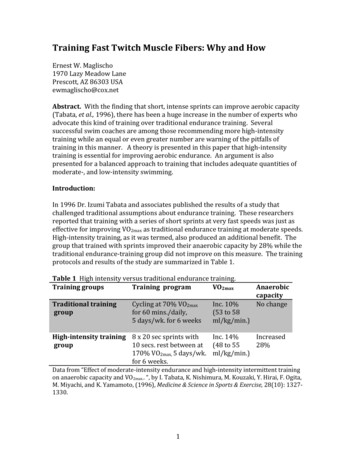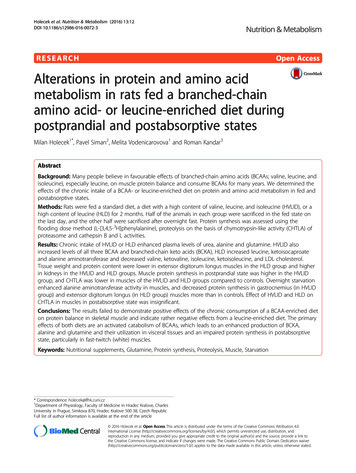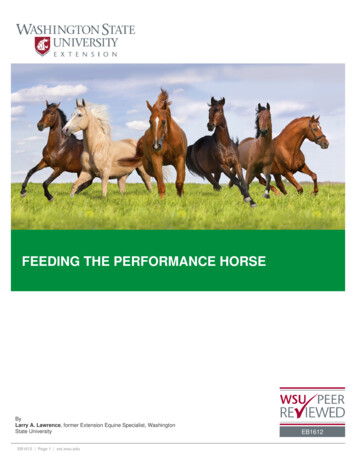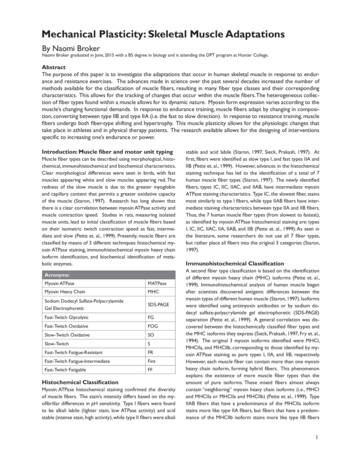
Transcription
Training Fast Twitch Muscle Fibers: Why and HowErnest W. Maglischo1970 Lazy Meadow LanePrescott, AZ 86303 USAewmaglischo@cox.netAbstract. With the finding that short, intense sprints can improve aerobic capacity(Tabata, et al., 1996), there has been a huge increase in the number of experts whoadvocate this kind of training over traditional endurance training. Severalsuccessful swim coaches are among those recommending more high-intensitytraining while an equal or even greater number are warning of the pitfalls oftraining in this manner. A theory is presented in this paper that high-intensitytraining is essential for improving aerobic endurance. An argument is alsopresented for a balanced approach to training that includes adequate quantities ofmoderate-, and low-intensity swimming.Introduction:In 1996 Dr. Izumi Tabata and associates published the results of a study thatchallenged traditional assumptions about endurance training. These researchersreported that training with a series of short sprints at very fast speeds was just aseffective for improving VO2max as traditional endurance training at moderate speeds.High-intensity training, as it was termed, also produced an additional benefit. Thegroup that trained with sprints improved their anaerobic capacity by 28% while thetraditional endurance-training group did not improve on this measure. The trainingprotocols and results of the study are summarized in Table 1.Table 1 High intensity versus traditional endurance training.Training groupsTraining programVO2maxTraditional traininggroupCycling at 70% VO2maxfor 60 mins./daily,5 days/wk. for 6 weeksInc. 10%(53 to 58ml/kg/min.)AnaerobiccapacityNo changeHigh-intensity training 8 x 20 sec sprints withInc. 14%Increasedgroup10 secs. rest between at (48 to 5528%170% VO2max, 5 days/wk. ml/kg/min.)for 6 weeks.Data from “Effect of moderate-intensity endurance and high-intensity intermittent trainingon anaerobic capacity and VO2max. “, by I. Tabata, K. Nishimura, M. Kouzaki, Y. Hirai, F. Ogita,M. Miyachi, and K. Yamamoto, (1996), Medicine & Science in Sports & Exercise, 28(10): 13271330.1
Training fast twitch muscle fibersDr. Tabata’s results were no “fluke”. They have been replicated in several additionalstudies. In one of these, previously well-trained elite cyclists improved their 40 kmtime trial performances by 3% after only four weeks by replacing 15% of theiraerobic-base work with six high-intensity training sessions (Lindsay, et al. 1996).On the high-intensity days the cyclists performed several five-minute efforts at 86%of VO2max, with one-minute rest periods between each repeat. In another study,participants increased VO2max by nearly 9% following seven weeks of sprint training.The subjects trained three times per week, doing four to ten, 30-second sprints eachsession, with 4 minutes rest between each sprint (MacDougall et al. 1998).How is it that training which has traditionally been thought of as anaerobic canproduce improvements of aerobic capacity that equal and in some cases surpassthose of traditional methods of endurance training for both untrained andpreviously well-trained subjects? I believe the answer to this question has to dowith the way that fast twitch muscle fibers are recruited during exercise.PurposeThe major purpose of this paper will be to describe a theory that explains why highintensity training can improve aerobic capacity. Additional purposes will be tooutline some types of repeat sets that are effective for training fast twitch musclefibers and to describe some questions that need to be answered about their training.The paper will be presented in two parts. In Part I the characteristics of the variousmuscle fiber types and how they are recruited during training will be discussed.Part II will focus on the how information in Part I can be used to training swimmers.Let’s begin with a description of the muscle fibers types and their characteristics.Characteristics of muscle fiber types in humansOver the last several decades it has become common knowledge that the muscles ofhumans (and animals) contain two distinct categories of fibers, slow twitch and fasttwitch. Slow twitch muscle fibers are also commonly labeled Type I, or red fibers,while fast twitch fibers have also been identified as Type II, or white fibers. Slowtwitch fibers are genetically very well suited for aerobic metabolism and, therefore,endurance work. At the same time, they have a limited capacity for anaerobicmetabolism. Fast twitch muscle fibers are very well suited for anaerobicmetabolism but much less so for aerobic metabolism. They contract rapidly andpowerfully but also fatigue more quickly than their slow twitch counterparts.Consequently, they are genetically best suited for sprint and power work.Slow twitch muscle fibers got their name because their time to peak contraction isapproximately 110 milliseconds. While contraction velocities in this range cannotreally be considered slow, they are relatively slower than those of fast twitch musclefibers which are in the range of 40 to 60 milliseconds (Brooks, Fahey, and Baldwin,2005).2
Slow twitch fibers have a generous supply of myoglobin, a substance that enhancesthe oxygen supply of those fibers. Myoglobin has a reddish pigment that gives slowtwitch fibers their dark red appearance. A function of myoglobin is to transportoxygen to the mitochondria of muscle cells where it can be oxidized, releasingenergy for contraction in the process. Figure 1a is a drawing of a single musclefiber showing the location of the various components that will be discussed in thefollowing paragraphs. An electron micrograph of a muscle fiber enlarged 250,000times is displayed in figure 1b. It shows the orderly arrangement of mitochondria,(multiple jagged black lines) within that fiber.O2(a)(b)Figure 1 Figure 1a is a drawing of a single muscle fiber. It shows the motor end plate where thecontractile impulse arrives and a capillary where oxygen diffuses into the fiber. Also shown aremitochondria. They are the structures where aerobic metabolism takes place. The role of myoglobinin transporting oxygen to the mitochondria is also represented. Figure 1b is an electron micrographof a muscle fiber showing the orderly arrangement of mitochondria (the black, jagged objects).As indicated, mitochondria, the so-called “power plants” of muscle cells, are thestructures wherein aerobic metabolism takes place. Mitochondria contain largesupplies of aerobic enzymes, such as citrate synthase (CS) and succinatedehydrogenase (SDH), that catalyze the aerobic breakdown of pyruvate andhydrogen ions to carbon dioxide and water. Slow twitch muscle fibers naturallycontain more mitochondria than fast twitch fibers.Another factor that enhances the endurance of slow twitch muscle fibers is the largenumber of capillaries surrounding them. This allows more oxygen to be delivered tothem via the circulatory system.Fast twitch muscle fibers tend to be naturally larger than slow twitch, and this,together with their faster speed of shortening, makes them capable of generatingmore power with their contractions. They also have greater supplies of myosinATPase, an enzyme that catalyzes the rapid release of energy from ATP and theycontain more creatine phosphate, the substance that replaces ATP more rapidly3
Training fast twitch muscle fibersthan any other chemical in the body (Bogdanis, 2009). In addition, they containlarger quantities of anaerobic enzymes, such as phosphofructokinase (PFK) and themuscle form of lactate dehydrogenase (M-LDH) that enable them to deliver energyfaster via anaerobic glycolysis, (the breakdown of muscle glycogen to lactic acid)(Pette, 1985). On the negative side, these fibers have less myoglobin and fewermitochondria, which reduces their capacity for aerobic metabolism. Untrained fasttwitch muscle fibers usually have a smaller number of capillaries surrounding themthan do slow twitch fibers which compromises their ability to absorb oxygen.Consequently, they fatigue more quickly.In humans, fast twitch muscle fibers have been further classified into two subcategories, FTa, and FTx fibers. The latter were formerly designated FTb fibers.However, that changed with the advent of a new system of fiber typing that relies onidentifying the number of myosin heavy chain filaments they contain. Heavy chainmyosin can combine with actin more strongly and at a faster cycling rate duringcontractions because it contains more of the enzyme myosin ATPase. (Brooks,Fahey, and Baldwin, 2005). As a result, fibers with heavy chain myosin will contractfaster. Fast twitch muscle fibers contain heavy chain myosin while the myosin inslow twitch fibers is of a lighter chain variety.Fast twitch A fibers, (also known as FT red, and Type II red fibers) have greaterquantities of myoglobin and mitochondria than FTx fibers, but, as mentioned earlier,less of these substances than naturally occurs in ST fibers. This gives the FTa fibersa somewhat more pinkish appearance than FTx fibers and makes them capable ofgreater aerobic activity and, therefore, greater endurance than FTx fibers.FTa fibers have greater anaerobic capacity than slow twitch fibers. To avoidconfusion in terms, let me explain that I refer to anaerobic capacity as the ability tometabolize muscle glycogen to lactic acid without the use of oxygen. It is commonfor some experts to also include the processes of lactate removal and musclebuffering under this heading. The first of these training effects allows more of thelactic acid and other metabolites that are produced during exercise to be removedfrom muscles while they are working (Brooks, Fahey, and Baldwin, 2005). Thesecond effect occurs when muscle fibers improve their ability to weaken (buffer)lactic acid. This slows the decline of muscle pH from its normally alkaline level of7.04, allowing them to release more energy anaerobically before acidosis (lowmuscle pH) occurs. Both of these training effects are considered anaerobic becausethey do not require oxygen. However, they are additional mechanisms for delayingmuscular fatigue and are not considered in my definition of anaerobic capacity.When the effect of these two processes, buffering and lactate removal, worktogether to delay muscular fatigue, it is often referred to as anaerobic endurance orspeed-endurance. I prefer the former term. It should be noted that FTa fibers havefaster rates of lactate removal and greater buffering capacity and, therefore, greateranaerobic endurance than either FTx or ST fibers (Noakes, 2001).4
There is still much to learn about FTx muscle fibers. We do know that they are thelargest and the fastest contracting muscle fibers of all. Consequently, they arecapable of producing the greatest amount of power. The power that fibers cangenerate is determined by a combination of their contractile force and contractilevelocity. As mentioned previously, contractile force is largely a consequence of fibersize. Fast twitch fibers are larger and faster than slow twitch with FTx being thelargest and fastest of all. Accordingly, FTx fibers, are capable of generating greaterpower. FTa fibers can generate up to 5 times the power of ST fibers whle FTx fibersare nearly twice as powerful as FTa fibers (Widrick, et al, 1996b). The graph infigure 2 illustrates differences in contractile power among the three fiber types atvarious percentages of maximum load.Differences in contraction power between ST,FTa and FTx muscle fibers at variouspercentages of maximum load90Fiber Newp to ow ne entage of maximum load90100Figure 2 Notice that all fibers achieve their greatest power production when the load isapproxiately 20% of the maximum capable by the fiber. This is because, the fiber is stillable to contract rapidly at this load, wheras, contractile velocity is slowed considerably athigher loads. Modified with permission from, “Muscle mechanics: Adaptations withexercise training,” by R.H. Fitts and J.J. Widrick. (1996), in J.O. Holloszy (Ed.), Exercise andSports Sciences Reviews (pp. 427-443). Baltimore MD: Williams and Wilkins,FTx fibers have the lowest aerobic capacity of the three muscle fiber types. Theyhave less myoglobin and mitochondria and, therefore, a decidedly less pinkappearance than FTa fibers. On the other hand, they, like FTa fibers, are rich inanaerobic enzymes and capable of rapid energy release via anaerobic glycolysis.5
Training fast twitch muscle fibersFTx muscle fibers have less buffering and lactate removal capabilities than their FTacounterparts and this contributes to their rapid fatigability. The differentcharacteristics of ST, FTa and FTx muscle fibers are summarized in Table 2.Table 2 Characteristics of ST, FTa and FTx muscle fibers.Muscle Fiber TypesCharacteristicsSlow TwitchFast Twitch aFast Twitch xAerobic (oxidative)CapacityHighModerateLowAnaerobic (glycolytic)capacityLowHighHighestMyosin ATPaseCreatinePhosphateBufferingcapacityLactate removalrateCapillaries perfiberContractilevelocityFibers per FastFastest 300 300 300LowHighHighestPowerLowHighHighestMost humans are born with approximately equal proportions of fast twitch and slowtwitch muscle fibers. The FTa fibers tend to predominate within the fast twitchcategory, and the percentage of FTx fibers is generally lower.While the middle 68% of the population have nearly equal percentages of fast twitchand slow twitch fibers, there are persons at either end of the bell-shaped curve whoare born with either a much higher percentage of slow twitch fibers or a muchhigher percentage of fast twitch fibers than the general population. These peopletend to excel in endurance or sprint/power events respectively.How are slow and fast twitch muscle fibers recruited during work?A common misconception is that slow work is performed by slow twitch musclefibers and fast efforts are executed by fast twitch fibers. Actually, neither of thesestatements is entirely true. Sub-maximal work is performed by the more aerobically6
efficient slow twitch muscle fibers while progressively more and more fast twitchfibers are recruited to assist them as the effort increases toward maximum.The orderly arrangement of muscle fibers into contractile units is depicted in figure3. Large muscles like the deltoid, are made up of groups of muscle fibers served by asingle motor nerve. These groups of fibers are termed motor units. Each motor unitcontains fibers of a similar type. Thus, even though a large muscle may contain allthree fiber types, the fibers within a particular motor unit will be of the same type,either ST, FTa or FTx.Motor units obey the “all or none” law. That is, if the nervous stimulation issufficient to cause the fibers within a motor unit to contract, all of the fibers in theunit will contract with maximum force. Thus, the muscular force that can be appliedby an athlete is largely due to the maximum number of motor units contracting atany one time and the types of motor units that are contracting. The motor units ofslow twitch fibers usually contain fewer than 300 fibers, whereas, the motor units offast twitch fibers have anywhere from several hundred to thousands of fibers. Sinceall of the fibers in a motor unit contract at once, and fast twitch motor units contain,not only larger fibers, but also more fibers, it is understandable that fast twitchmotor units will generate considerably more force when they contract.What has become known as the “size principle” of muscle fiber recruitment is alsoillustrated in figure 3. The order of recruitment is from ST to FTa to FTx motor unitsas the intensity of work increases. This is because of the size of the motor nerveinnervating the different categories of motor units. Smaller motor nerves requirethe least amount of nervous stimulation to excite their motor units to contract. Slowtwitch muscle fibers have the smallest motor nerves so they will be recruited toperform work that is easy to moderate in nature. Motor units with FTa fibers havelarger motor nerves and require a greater neural drive before they will be excited tocontract, therefore, they will not be recruited until the work intensity is beyondmoderate. The motor nerves of FTx fibers are the largest of all so they will not berecruited until the need for force and power approaches maximum. The illustrationin figure 3 also portrays differences in contractile velocity, contractile force, andfatigability between the three fiber types.7
Training fast twitch muscle fibersSlow Twitch (ST)Fast twitch A (FTa)Fast twitch X (Ftx)Figure 3 This figure illustrates several characteristics of ST, FTa and FTx motor units.Notice that the motor nerve that serves the ST fibers is smaller than the other two. It has alower threshold for excitation so that slow twitch fibers can be recruited at low levels ofeffort. The motor nerve serving FTa fibers is larger and requires a greater amount ofexcitation before the electrical messages it sends to its fibers causes them to contract. Thus,FTa fibers will not be recruited until the level of effort is moderate to high. The motor nervethat innervates FTx motor units is the largest of all so it will require the most stimulationfor its fibers to contract. The set of graphs just below each motor nerve indicate thefatigability of the fibers in that motor unit. You will notice that the FT motor units fatiguemore rapidly than the ST, and that, within the fast twitch group, FTx motor units fatiguemore quickly than FTa motor units. The next set of graphs displays contractile speed andforce. ST motor units contract slowest and with the least force. FTa contract considerablyfaster and with greater force. FTx motor units are the largest and fastest contracting, sothey generate the greatest amount of force.Modified from Biology of Physical Activity (p. 53), by D.W. Edington, and V.R. Edgerton.(1976), Boston, MA: Houghton-Mifflin, with permission.To be precise, the order of muscle fiber recruitment results from the force or powerrequired to perform a movement, and not the speed needed to perform it. Forexample, slow twitch muscle fibers will be recruited to perform a fast movementthat requires little force, like spinning on a bicycle ergometer, while lifting a heavyweight very slowly would require the recruitment ST, FTa and FTx fibers nearlysimultaneously. It happens, however, that in most athletic activities, an increase ineffort is also accompanied by an increase in speed, so, in a sport like swimming,,increases in effort are usually accompanied by increases of speed. Hence, the termsforce, power, intensity and speed are often used interchangeably when discussingthe order of muscle fiber recruitment.8
The proposed pattern of recruitment for fast and slow twitch muscle fibers can berepresented by a graph like the one in figure 4. This graph illustrates the so-called“ramp effect of muscular contraction” (Wilmore and Costill, 1999).Figure 4. The ramp effect of muscle contraction. The graph shows that progressivelygreater and greater numbers of muscle fibers are recruited as athletes swim faster. Slowtwitch are the first fibers to be recruited. FTa fibers are added to the effort as speedincreases. FTx are the last fibers to be recruited and this occurs when speeds are nearmaximum. Chart modified with permission from Physiology of Sport and Exercise, (p. 50) byJ.H. Wilmore, and D.L. Costill, (1999), Champaign, IL: Human Kinetics.To summarize what was said before, at low levels of effort it is primarily the slowtwitch muscle fibers that do the work. When the effort increases, fast twitch musclefibers will be recruited to assist (not replace) their ST counterparts. FTa fibers arethe first of the fast twitch group to be recruited as the effort increases, with FTxfibers recruited to assist both the ST and FTa fibers as the effort approachesmaximum.The threshold for significant FTa fiber recruitment is believed to approximate aworkload that corresponds to the lactate threshold (Brooks, Fahey, and Baldwin,2005). Since fast twitch fibers produce more lactate than slow twitch fibers duringwork, the exponential rise in blood lactate at workloads exceeding the lactatethreshold probably occurs because significant numbers of FTa fibers are nowcontracting. Although no threshold for recruitment of FTx fibers has been posited, itis reasonable to assume, based on research with rats that will be presented later,9
Training fast twitch muscle fibersthat they will not contribute substantially to a particular effort until the intensityapproaches or exceeds 100% of VO2max .Before leaving this section, I should mention that muscle fatigue causes a similareffect on muscle fiber recruitment to that of work intensity. As indicated earlier, STfibers, and, perhaps, some low threshold FTa muscle fibers will be recruited firstduring long training sessions when most of the swimming is done slower thanlactate threshold speed. However, after 1 to 2 hours many of these fibers will lose alarge portion of their fuel supply and become fatigued. When this happens, thenervous system will recruit additional FTa fibers to maintain the desired swimmingspeed. Even later, when most of the ST and FTa fibers are nearly exhausted, FTxfibers will be recruited to preserve that speed (Wilmore, et al., 2008).Unfortunately, the FTx fibers will fatigue quickly after recruitment and the swimmerwill have to reduce his or her pace considerably soon after they join the effort.The fact that FTa and FTx fibers are recruited when ST fibers lose glycogen couldexplain why long-slow distance training has been effective for improving theendurance of fast twitch muscle fibers. But, is this the most efficient and effectiveway for doing so. I doubt it. For one thing, muscle glycogen depletion will besevere after each session and trying to train from day to day with an inadequatesupply of fuel may cause failing adaptation. For another, there is no need to trainfast twitch fibers in this manner when there are potentially less harmful ways to doso. In part two of this paper I will discuss the effects of training on muscle fibers andhow to train to achieve those effects.The Effects of Training on Muscle Fibers:It is well documented that training improves the aerobic capacity of FTa fibers sothat they fatigue less rapidly. The mitochondria become larger and more numerousand the number of capillaries surrounding them increases (Holloszy, 1967). Theaerobic capacity of trained FTa fibers often approaches that of untrained ST fibers(McArdle, Katch and Katch, 1996). Training will also elevate their buffering capacityand lactate removal rates, which will increase the time they can assist ST fibers inmaintaining a particular pace.There are strong indications in the literature that the aerobic capacity, bufferingcapacity and lactate removal rates of FTx muscle fibers can also be increased withtraining until they function much like FTa fibers. One such indication is that fiberspreviously typed as FTx become less numerous while those typed as FTa fibersbecome more numerous after training. The data in Table 3 shows the results of astudy where a group of college students were subjected to eight weeks of resistancetraining (Andersen, et al, 2005). Muscle biopsies and subsequent fiber typingshowed a decrease in the number of FTx fibers and a concomitant increase in FTafibers after training. The training program in this study consisted of 4 to 5 sets ofleg presses, hack squats, knee extensions and leg curls, performed three daysweekly, for three months. Subjects began training with 10-12 repetitions of each10
exercise, increasing weight and decreasing repetitions through the course oftraining until they were performing 6 to 8 repetitions of each.Table 3 The effects of training on muscle fibers.Fiber type percentagesFiber typesBefore trainingAfter trainingDifferenceSlow twitch60600Fast twitch a3439 5Fast twitch x61-5Data from “Changes in the human muscle force-velocity relationship in response toresistance training and subsequent detraining,” L.L Andersen, et al. (2005), Journalof Applied Physiology ,99: 87-94.These results seem counterintuitive in that one would expect training with a highpower output would encourage a switch from FTa toward FTx fibers types insteadof the other way around. This is not the case, however. A consistent finding is thatFTx fibers respond by gaining aerobic and anaerobic endurance whether thetraining program is made up of endurance or sprint/power activities.An unwelcome consequence is that the contraction speed and, therefore, the powergenerating capacity of FTx and FTa fibers decreases as they become trained evenwhen that training consists of sprints and weight training (Andersen, Klitgaard, andSaltin, 1994; Widrick et al., 2002).Slow twitch muscle fibers are also amenable to training despite their alreadygenerous supplies of capillaries, mitochondria, and aerobic enzymes. The quantitiesand activities of each will be enhanced considerably by training, in addition toimproving the ability of ST fibers to metabolize fat for energy (Philips, 2006).Information in the literature is scarce concerning the effects of training on themechanisms of anaerobic metabolism, buffer capacity and lactate removal in STfibers. I would assume each of these would also be improved with high intensitytraining. However, considering the affinity of these fibers for aerobic metabolism, Isuspect the degree of improvement would be slight. One significant finding hasbeen that any type of exercise, whether it is endurance or sprint in nature, willincrease the contractile velocity of slow twitch muscle fibers and thus, their abilityto generate power (Widrick, et al, 1996a). Resistance training will also increasetheir size, further increasing their ability to generate force and, thus, power(MacDougall, 1986; Roman, et al, 1993).One recently discovered response to training the slow twitch muscle fibers is anincrease in the lactate transporter MCT1 (Bonen, 2006). MCTI is one of severaltypes of monocarboxylate transporter proteins. Its purpose is to transport lactatefrom the blood and adjacent fast twitch muscle fibers into slow twitch fibers whereit can be carried to their mitochondria and metabolized. MCT1 is found in greatest11
Training fast twitch muscle fibersquantity in ST muscle fibers and in smaller quantities in FTa fibers. Very little, if anyof this particular lactate transporter is found in FTx fibers. An increase shoulddelay fatigue by increasing the ability of slow twitch muscle fibers to absorb lactate.The chain reaction effect would be that acidosis, and thus, fatigue, would be delayedin FT fibers if, during training and competition, more of their lactate wastransported into slow twitch fibers where it could be stored and oxidized. (Lactateis transported out of fast twitch muscle fibers by another lactate transporter,designated MCT4. This transporter is also increased with training)The results of some studies have shown that fast twitch fibers can gain enoughmyoglobin and mitochondria to be typed as slow twitch muscle fibers after trainingand vice versa. In one of these, the percentage of ST fibers decreased from 52% to41% after three months of strength and interval training (Andersen, Klitgaard, andSaltin, 1994). At the same time, the percentage of FTa fibers increased from 35% to52% and the percentage of FTx fibers decreased from 13% to 5%. This leaves openthe possibility that training could cause a conversion of slow to fast twitch musclefibers or the other way around. In fact, some experts have postulated the existenceof an FTc fiber that may, through training, be converted to either a FTa or ST fiber(Wilmore, Costill, and Kenney, 2008). Brooks and his associates (2005) have alsoindicated the presence of hybrid muscle fibers that contains elements of both ST andFTa fibers. It is conceivable, but not proven, that hybrids of this type could beconverted in either direction with proper training.Despite these findings, the prevailing opinion is that FT fibers cannot be convertedto ST and vice versa. At the present time, most experts believe that conversions ofthe two fiber types can only be produced by surgically changing the motor nerveinnervating them. In other words, the motor nerve that serves a slow twitch motorunit would have to be surgically connected to a fast twitch motor unit before aconversion of FT to ST fibers could take place. The reason for reports of traininginduced changes of slow to fast twitch fibers and vice versa in the literature may bedue to difficulties in fiber typing. It is a complex and painstaking procedure fraughtwith possibilities for error. Nevertheless, the controversy concerning whether slowand fast twitch muscle fibers can be converted from one to the other with training isfar from resolved.Implications for training rowers.The previous information was presented for the purpose of drawing the reader’sattention to an important, but frequently overlooked, feature of training. It is, thatan athlete must improve the aerobic capacity of both their slow and fast twitchmuscle fibers in order to maximize VO2max. It is not sufficient to work only at lactatethreshold and sub-threshold speeds to accomplish this. Those training intensitieswill improve the aerobic capacity of slow twitch muscle fibers and perhaps somelow-threshold FTa fibers. At the same time, however, most of the FTa and very fewFTx fibers will be recruited and trained.12
As indicated earlier, the major effect of training on fast twitch muscle fibers appearsto be very similar regardless of their type. They undergo changes that make themmore enduring. When they are used to perform work they improve their capacityfor aerobic metabolism by increasing capillarization and mitochondria regardless ofwhether they
Fahey, and Baldwin, 2005). As a result, fibers with heavy chain myosin will contract faster. Fast twitch muscle fibers contain heavy chain myosin while the myosin in slow twitch fibers is of a lighter chain variety. Fast










